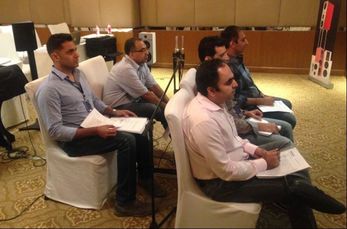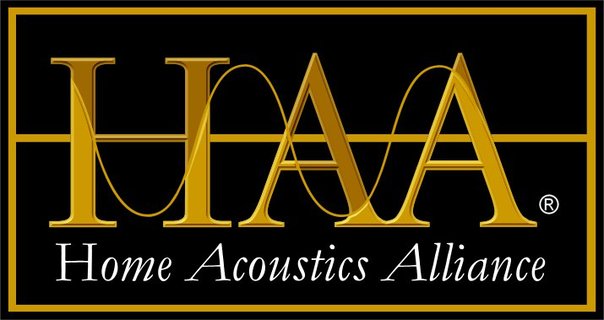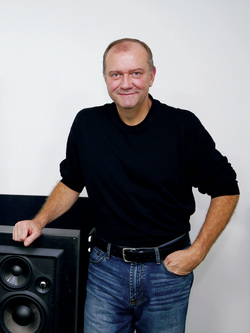What is Home Acoustics Alliance (HAA) Training?
The HAA is all about “Great Sound Through Science”. They've been providing the industries best audio and acoustics training for over 20 years. their graduates include some of the best integrators and manufacturers in the business. HAA Certifications are recognized throughout the Custom world as the mark excellence and professionalism.

HAA will be offering three training certifications and classes. The new training provides three levels of certifications. The new training takes the best of HAA to do the finest audio training in the industry. With important discussion topics like Dolby Atmos, new acoustical treatment strategies, a new, more efficient calibration process, and more. This session will be fun and extremely useful for the Pro who wants to be the best. In addition, we prefer to think of our Pro Graduates as members of the HAA. This website aims to provide the best after-the-class support to aid in problem-solving and continue the learning experience. We are available to consult by phone or digitally to make sure you are successful. Small room acoustics is a technical endeavor, and we realize one trip to a class may need some refreshing.
- In depth technical explanations geared for an integrator to become an expert or the expert to become the best!
- Learn the latest state-of-the-art techniques to design acoustically perfected listening rooms including correct speaker, seating, sub-woofer, and acoustical treatment placement; there’s more here than just angles and rules-of-thumb. Learn to adapt based on the room!
- Follow-on support via the HAA community and web portal.
- True hands-on work during the Integrator and especially the Advanced Integrator Workshops.
- Time tested and recommended training with new ideas for maximizing sonic performance: HAA has been training integrators for many years.
- An introduction to professional listening techniques in the Integrator Workshop.
- Extensive listening training in the Advanced Integrator Workshop.
- Correct use of audio analysis tools (RTA, FFT, ETC) and use of the AVPro Report Writing Software.
- Equalization training and, in the Advanced Integrator Workshop, actual calibration of a parametric EQ.
- Small class sizes; Advanced Integrator Workshop is limited to 6 students.
HAA HT1 Home Cinema Design Certification (now online as the HAA Level One course):
This class teaches the fundamentals of proper Home Theater acoustical design. It provides the central requirements of a high-performance design based upon state-of-the-art scientific research and extensive field experience. The concept of the "Acoustical Framework" is introduced as the central design concept explaining the importance of all acoustical elements in achieving a delicate balance based on their interdependency. The list of guiding metrics of design success is also introduced with discussions on how the acoustical framework and acoustical treatment strategy can be understood as the central controls of performance. The course lays the groundwork for a further, more advanced understanding of small room acoustics by introducing the student to the most critical industry acoustical terms and their technical descriptions providing an essential grounding for the Professional. It's ideal as an introduction to small room acoustics for all professionals, but it offers new insights on high-performance design for more advanced students. It's also a must-attend class for theater designers, AV salespeople, project managers, and every integrator. They'll discuss professional design requirements for room construction and room layout. There are new ideas here that you likely haven't heard about. While the material is technical, the class will focus on creating a clear understanding using basic terminology and discuss ways for integrating proper acoustical design with modern interior design preferences. It includes a step-by-step design of a standard room but discusses many possible variations. The class explains key acoustical design elements, including multiple subwoofer placement, optimized seat positions, LCR placement around a video screen, screen placement, high channel count surround and top speaker placement, and the most thorough discussion of acoustical treatment strategies to date. It explains best practices for client discussions and how technical excellence and knowledge can drive business goals.
HAA and CEDIA have partnered to provide HAA Training. Our first collaboration is the HAA Level One “online” Class. We’ll explain how to enroll in the following paragraph. We are also working together to provide more in-person advanced workshop dates and locations; click here to see the latest: Event Schedule Link. The Level One online course is only accessible through the CEDIA website. The online class is open to all, but it requires a free registration on the CEDIA website. Pro Integrators who are full members of CEDIA in good standing or elect to become CEDIA members can receive a Member discount; you’ll already have access to the website. CEDIA Membership is for Pros, CEDIA Registration is open to all.
To Enroll in an HAA Online Class
Register with CEDIA: CEDIA Registration Link (CEDIA membership is not required; free registration). This is for access to the CEDIA website unless you already have access.
Look for Classes: Once you have access, log in to CEDIA.net and scroll down for the “Events and Education” section. Click “Browse CEDIA’s online education” or CEDIA Academy for the HAA Level One Online Course. For the in-person courses that are scheduled, click the “See all in-person training and events” or Event Calendar link.
To Enroll in an HAA Online Class
Register with CEDIA: CEDIA Registration Link (CEDIA membership is not required; free registration). This is for access to the CEDIA website unless you already have access.
Look for Classes: Once you have access, log in to CEDIA.net and scroll down for the “Events and Education” section. Click “Browse CEDIA’s online education” or CEDIA Academy for the HAA Level One Online Course. For the in-person courses that are scheduled, click the “See all in-person training and events” or Event Calendar link.
HAA HT2 Integrator Certification (2 days):
This is an advanced how-to design/calibrate class evenly split between classroom training and a hands-on workshop. While created for integrators, it is excellent for designers, project managers, and even enthusiasts. The class leverages the HT Design principles introduced in the HT Adviser class with more technical explanations and examples. It discusses acoustical principles to create a deeper understanding of HAA design standards to prepare the student with better problem-solving skills. The class begins with the HAA TurboCal Workshop designed to start running with an efficient and practical audio calibration process; they will calibrate a live system during the workshop. Training high points include learning how to use an FFT and RTA analyzer, being a pro listener, calibration documentation, advanced sub-woofer calibration, speaker and seating placement, and designing a practical acoustical treatment strategy. A prerequisite is previous HT1 class attendance within the past year. Don't forget there are discounts for retaking classes for past HAA Students.
HAA HT3 Advanced Integrator Certification (2 days):
This workshop is an all-hands-on session designed to bring all the prerequisite training to the test. This class pulls all the information and techniques from the prerequisite classes into a fantastic review and cements the concepts for a complete understanding. The student is teamed with no more than 5 others who are tasked to design and calibrate a high-performance system incrementally. Nothing less than impressive results is allowed. The team is asked to complete the HAA PowerCal process, including several eye-opening instructor-led learning sessions conducted with your audio system. You'll understand subwoofer placement, room modal analysis, speaker/seating placement, and acoustical treatment design from both a theoretical and experiential point of view. Our rule is that nothing is changed without measuring and hearing the difference the change creates. This class will forever alter your perspective on audio and reveal new opportunities in building high-performance systems. Prerequisite is previous HAA HT2 Integrator class attendance within the past year.
What to Bring:
You are welcome to bring your laptop and test gear for tool-specific advice, but it is not used in the class: Laptops and test gear will be provided. Lunch is provided, but lodging and travel are not. Cancellations are not allowed within 30 days of the event. Refunds are not possible, but an effort will be made to accommodate you in the next available class within one year.
About Your HAA Instructor: Gerry LemayGerry Lemay is the Founder of the Home Acoustics Alliance (HAA), and President of Quest Acoustical Interiors Inc.. He has extensive experience in consumer electronics technology and acoustics first entering the industry in 1977. He has worked as business executive in CE retail and manufacturing, and spent 28 years in the US Navy Reserve recently retiring as a Captain.
Gerry has designed hundreds of theaters worldwide and taught hundreds of seminars and workshops on high performance audio design and calibration throughout the world. This includes the highly successful development of the HAA China and now HAA India. His work with CEDIA over the years has been as subject matter expert, instructor, course writer and the update of the newest version of the CEDIA Technical Reference Manual’s section on audio. |
Why Should I Attend?
The Home Acoustics Alliance has developed the foremost course for Home Theater Acoustics design and performance. Whether you are seeking improvements in an existing system or building a new one, the course provides the framework and knowledge to practice acoustic design and calibration in the field. The various "Elements" that outline this framework are reviewed by the acoustical calibrator and graded based upon how well they conform to industry standards. The calibrator then has the information necessary to "pro"scribe the required changes to bring performance up to its best. The final analysis of performance is then summarized in a concise System Performance Report judging performance based upon our fundamental acoustical goals (see below). These goals are common to to all home sound systems. If your current AV Contractor is not HAA Certified, many consumers will hire an HAA Calibrator to review a proposed design as an outside consultant.
Accreditation:
Acoustic Goals:
|
Clarity
Clarity is the prime acoustical goal because its perfection depends on the successful attainment of all other goals. Of paramount importance is dialogue intelligibility in movies, but one must be able to understand musical lyrics, detect quiet background details, and sense realism for acoustical sounds. Elements that affect this goal are varied including equipment quality, room reverberation levels, ambient noise levels, and listener position among others. |
Focus
The ability to precisely locate each reproduced sonic cue or image in a three-dimensional space is defined as acoustical focus. Recordings contain many such images superimposed side to side and front to back in every direction for 360 degrees around the listener. A system is said to have pin-point focus if, from the perspective of the listener, each of these images is properly sized, precisely located, and not wandering. Good focus also provides that individual images be easily distinguishable from amongst others within the limits of the recordings quality. |
|
Envelopment
An audio system should reproduce virtual images of each recorded sound presenting the listener with its apparent source location in a three-dimensional space. Each sonic image relates a part of the recorded event and together these sounds compose a wrap- around sound-stage that envelopes the listener. Proper envelopment requires that the sound-stage be seamless for 360 degrees without interruption by holes or hot spots caused by speaker level imbalance or poor placement. While envelopment requires three-dimensional imaging of all sonic cues, of pivotal importance is the realistic recreation of the ambient sound field of the recorded venue. Focused sounds become more realistic as they move side to side and front to back with the backdrop of the ambient sounds of the intended venue. |
Dynamics
Dynamics is simply defined as the difference between the softest and loudest sounds reproducible by a sound system. While much emphasis is placed on the loudness side, it can be shown that the audibility of the softest sounds is an equal measure of system performance. Among the acoustical requirements for proper envelopment, focus and clarity is the necessity of hearing the sonic cues relating these qualities. If they are overwhelmed by excessive ambient noise or reverberation in a room, they are not properly audible. At a minimum, a system must be capable of reproducing loud passages with ease and without excess while soft sounds remain easily audible. |
Response
The frequency response of a system is a measurement of the relative levels of all reproduced audio frequencies. The smoothness of response can be observed in a variety of ways; as improper tonal balance including boomy bass, excessive treble, improper musical timbre, or a general lack of realism. Factors of importance include selection of high quality components, and proper system set-up including (in a small room) proper listener position, speaker position, and correct use of equalization. At a minimum, the system must be non-fatiguing all sound levels, articulate and faithful to the original signal.
The frequency response of a system is a measurement of the relative levels of all reproduced audio frequencies. The smoothness of response can be observed in a variety of ways; as improper tonal balance including boomy bass, excessive treble, improper musical timbre, or a general lack of realism. Factors of importance include selection of high quality components, and proper system set-up including (in a small room) proper listener position, speaker position, and correct use of equalization. At a minimum, the system must be non-fatiguing all sound levels, articulate and faithful to the original signal.




